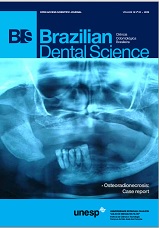Impact of monomer functional groups of resin-based materials on the interaction with water
DOI:
https://doi.org/10.14295/bds.2015.v18i2.1096Abstract
Objective: The objective of this in vitro study was to compare dentin bonding systems and composite resins based on their functional groups in terms of water sorption (WS) and water solubility (WSB). Material and Methods: Three dentin bonding systems (Adper Single Bond 2 – 3M ESPE, Clearfil SE Bond – Kuraray, P90 Adhesive System – 3M ESPE) and three commercial composite resins (Filtek Z350 – 3M ESPE, Filtek Z250 – 3M ESPE, Filtek P90 – 3M ESPE) were tested. Eight specimens of each material were prepared to evaluate the WS and WSA. The discs were individually stored in a desiccator until constant mass was achieved. Specimens were then individually stored in distilled water until the mass was stabilized again. Finally, the specimens were dried again in the desiccator until constant mass was obtained. WS and WSA were calculated from these measurements. Data were analyzed by one-way ANOVA and Tukey post hoc test (p < 0.05). Results: Filtek Silorane-Bond presented the lowest values of WS, and Clearfil SE Bond presented the lowest WSB. Filtek Silorane resin showed the lowest WS and WSA results. Conclusion: Based on the results, it can be concluded that the WS and WSB were influenced by the composition of the materials. The main functional group of the materials determines their susceptibility to water and influences their performance.
Downloads
Downloads
Published
How to Cite
Issue
Section
License
Brazilian Dental Science uses the Creative Commons (CC-BY 4.0) license, thus preserving the integrity of articles in an open access environment. The journal allows the author to retain publishing rights without restrictions.
=================




























